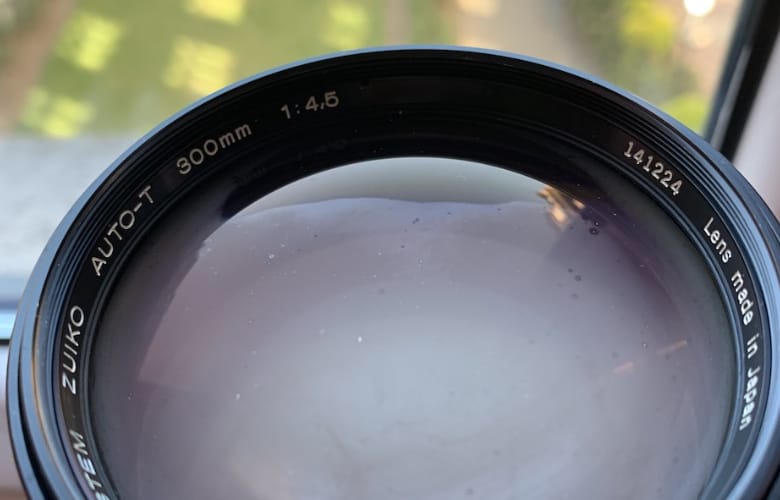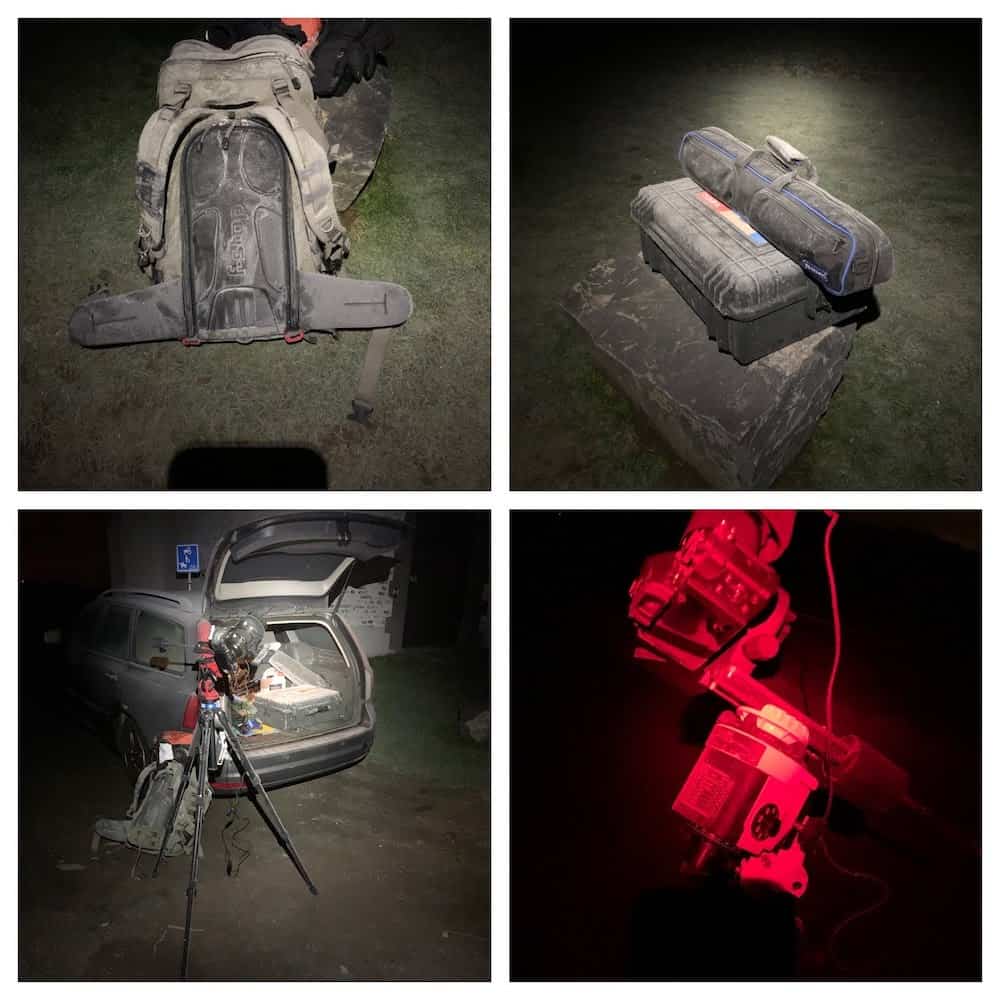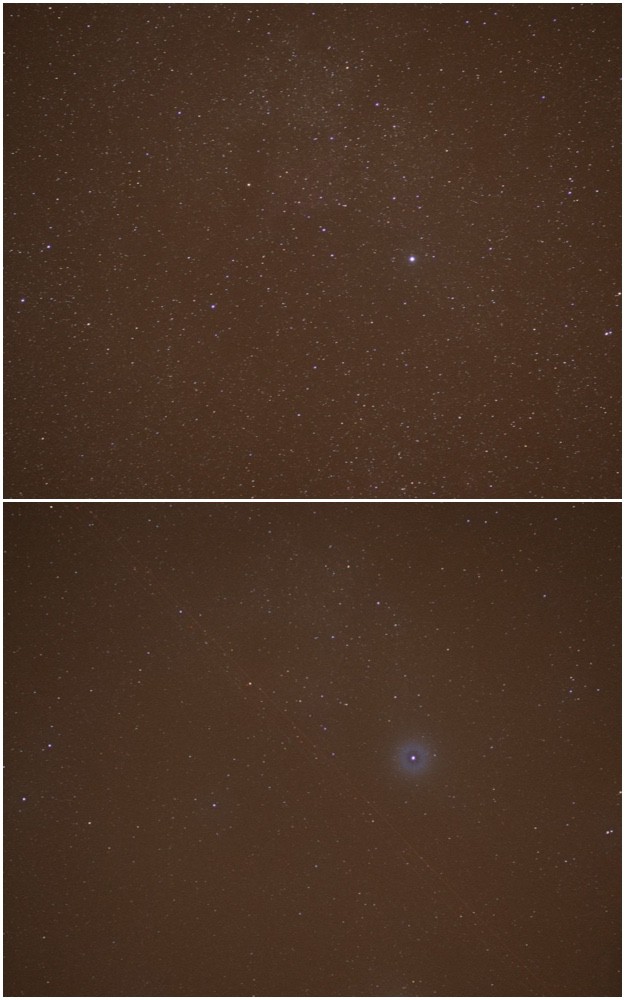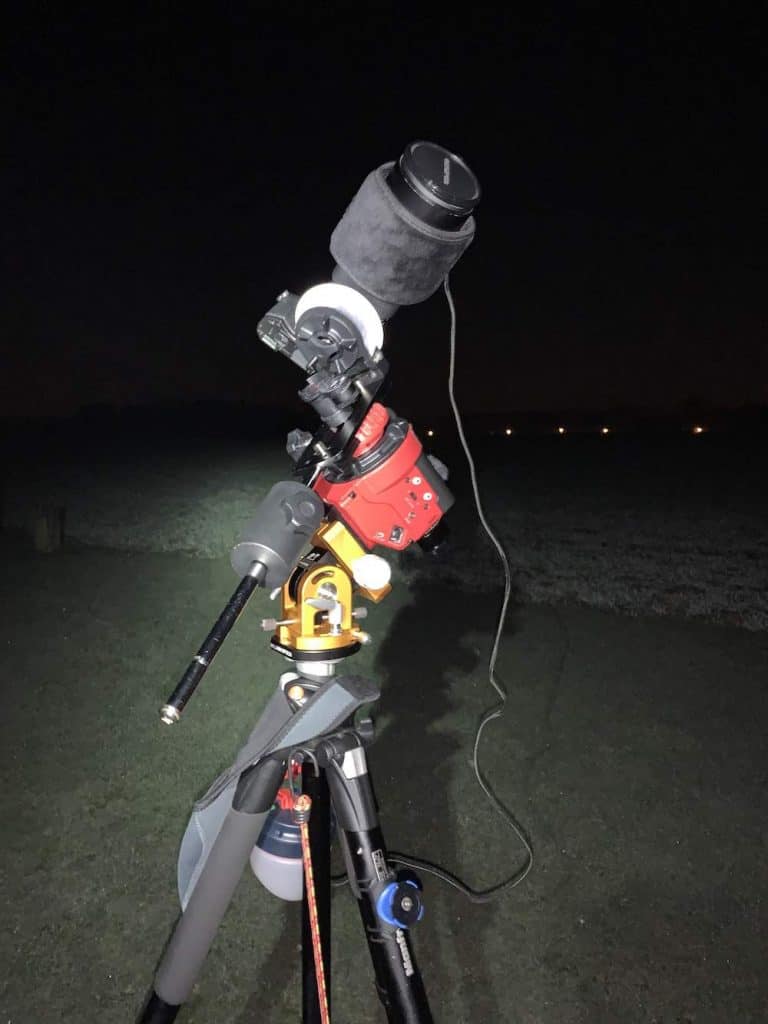How To Keep Camera From Fogging Up
Lens fogging is ane of the many curses in astrophotography. Yous don't really think nearly lens fogging until you take wasted a skilful night because of it.
In this article, I'll teach you why lens fog and how to avoid this.

What Is Lens Fog?
If you employ spectacles, you are familiar with the whole fogging conundrum.
Lens fogging is no unlike, and information technology is a well-known trouble when shooting in certain ambient weather, particularly in humid environments.

Why Does Condensation Occur On A Lens?
Assuming yous are not shooting for astrophotography under the rain or in thick fog (and why would you lot, anyway?), several factors make up one's mind whether your camera lens will fog or not:
- The Air Humidity
- The Air Temperature
- The Lens Temperature
- The Dew signal
While this section may await like a boring and technical 1, this data will help yous to have a better chance of success when doing astrophotography.
This is a lesson I learned the hard way myself, and I suggest you keep reading.
Because the argument can go very technical very apace, allow me to quote and break down some info I found while searching Wikipedia for Dew Betoken.
Information technology should be articulate by at present that the key to everything is the Dew Point and how information technology compares with air temperature, humidity, etc.
This is how the dew bespeak is defined:
"The dew point is the temperature to which air must be cooled to go saturated with water vapor. When farther cooled, the airborne water vapor will condense to grade liquid h2o (dew) […]". From Wikipedia.
And these are the implications when because the air temperature and surface temperature with respect to the dew signal:
"[…] When air cools to its dew point through contact with a surface that is colder than the air, h2o will condense on the surface. […]"
"[…] When the temperature is below the freezing signal of water, the dew indicate is called the frost point, as frost is formed rather than dew. […]"

And finally, to complete the picture, here is the relation between the dew point and humidity:
"[…] The measurement of the dew betoken is related to humidity. A higher dew indicate means there is more moisture in the air."
Ok, permit'due south cut to the chase now: when a photographic lens will fog?
To put it simply, a lens volition fog when the temperature of the front end glass of the lens (or the photographic filter you have on it) dips a few degrees below the dew bespeak.
The common cold drinking glass volition make the water vapor in the air condense on it, particularly if there is no air motion to help reduce the condensation.
Here a couple of examples to understand better why condensation occurs:
- Take your glasses or a lens and breathe on them. Since your breath has high humidity, its dew point is well above the ambient temperature. When your hot and humid breath meets the colder glass, the water in information technology will condensate on the glass.
And this is how we clean our glasses or fog our lenses to create artistic furnishings. - The same principle is responsible for the fogging of your bathroom mirror when you accept a hot shower.
Why Is Condensation a Problem?
In photography, in that location are two different aspects to consider when information technology comes to condensation: the gear and the image quality.
Condensation Vs Your Gear
You practice not desire condensation to form on your sensor, inside your camera, and inside your lens and y'all have to reason in terms of temperature difference:
- Exposing your gear to a colder environment does not create condensation. This is because your photographic camera is hotter than the air around it, thus well in a higher place the ambient dew point.
- While working, your camera generates heat: this will prevent condensation from forming inside your photographic camera trunk, but you may have problems with your lens.
- Exposing common cold equipment to a hotter environment volition cause condensation to form. Bringing your camera in your home after hours spent shooting stars on a cold night is the worst thing you lot could practice.
The proper manner to avoid condensation within your gear is to put your photographic camera in your camera bag at the end of the session, before going back within.
Alternatively, put your gear within a zip handbag and seal with some cold air trapped inside.
This allows your gear to slowly thermalize while avoiding condensation. For extra protection, yous tin can throw in your camera purse some silica bags to help blot moisture.

Await 12/24 hours before taking the camera out. If you are in a hurry to run across your photos, before putting your camera away, take out the sd bill of fare.
Condensation Vs Image Quality
While in the field, condensation tin can cause your lens to fog, thus dramatically reducing the epitome quality.
The faintest stars volition disappear from view, the brightest one volition create halos, and the prototype will get a full general soft look.

How To Forbid Condensation On Your Lens
Preventing condensation to form on your lens is the way to get. To defog a fogged lens will exist more difficult.
And when it comes to preventing fogging, the fundamental is to command the temperature of your gear, and so that it stays warmer than the ambience dew betoken.
Serious astrophotographers using telescopes often make use of high-end equipment to forbid fogging their optics: 12V controllers, 12V power tanks, and heating strips.
For united states of america astrophotographers on a budget, using camera lenses and pocket-sized telescopes, there are a couple of simpler (and cheaper) solutions.
5V DC USB Heating Strips: The Best Solution

This is past far the all-time solution to keep your lens from fogging.
Coowoo is a make of affordable heating strips. Yous can purchase these kinds of strips from Amazon. I take several strips from Coowoo, with and without temperature command, and all work as expected.
All you lot need next is a decent ability banking concern to power them via a USB 5V port.
This solution is a very lightweight and flexible solution, by far the one I recommend the near.
Here in that location are a couple of tips for using heating strips:
- Always use the lens hood: this alone helps to preclude condensation, merely information technology also provides a place to mount the heating strips without obstructing the view.
- Be careful not to move the lens focusing ring while installing the strip. This may be a problem with lenses with a very smooth focusing ring, and you may demand to tape information technology down. Don't be lazy and always take a test shot to confirm your focus is still spot-on.
- You do not demand to cover all of your lens with the strip: just make sure the strip wraps nicely tight around the lens near the front end chemical element and the lens hood.
- Once you lot take the strip, don't be lazy and install it every fourth dimension y'all are doing astrophotography: summer nights tin can go cold and humid, and lens fogging can nevertheless happen occasionally.

Paw Warmers: A DIY and Fill-in Solution

Using a hand warmer is a more DIY solution to forbid lens fogging. Merely strap one or two of those to your lens using a condom ring.

The downside of this solution is the cost of the long catamenia and the possible seasonal availability of the paw warmers.
Nonetheless, have a couple of hand warmers on your camera bag, in case your power banking concern is empty or your heating strip is not working.
Too Late: How Do You Get Moisture Out Of A Photographic camera Lens?
Has your lens fogged upward?
Practice not showtime wiping the lens trying to remove information technology: you may scratch the lens if you have grit or dirt on it, and condensation will form presently after.
If yous don't have anything with y'all to warm the lens to a higher place the dew indicate, call the nighttime off and if y'all have 1, place them in a dehumidifier storage cabinet.
If you forgot to install the heating strip or manus warming, install them on the lens and wait for the condensation to evaporate.
Blowing on the lens or using a cordless hair dryer can speed up the evaporation process.
How Knowing The Dew Point Improves Your Images
You may think I could have discussed lens fogging in a single judgement, something similar: get a heating strip fitted on your lens, plug information technology to a power depository financial institution, and you will never have your lens fogged once more.
This may be true, just interestingly, by understanding why a lens fogs upwardly, you will exist able to better your astrophotography.
How is it so? Because part of the answer to "why lenses fog up?" is the respond to a unlike, and equally of import, question: "volition it be foggy out there tonight?
If you, like me, are forced to drive up to 150km one mode outside the city to avoid light pollution, you lot may want to know what chances are it will be foggy out in that location.
Whether apps such as Clear Exterior can tell you whether you may find fog at your location. Clear Outside as well gives you forecasts on the Dew Indicate for your location.

These are, of form, forecasts, merely if you see the local temperature is flirting with the dew point, there will be a good chance fog and brume volition rise during the night.
This is particularly true if you are close to bodies of water, such as lakes and rivers, or you are inside or near a valley or ground depression.
If you can, use this information together with your noesis of different locations to pick the one that gives you the all-time chances to success:
- Pick a location for which the temperature is well in a higher place the dew point.
- Avert places near water (sea, lakes, rivers, marsh, etc.).
- Favor college basis rather than staying inside a valley.
- Favor "open" locations, where the breeze can move the air and reduce the ambient humidity.
Conclusion
Lens fogging is one of the many little problems that nosotros confront in astrophotography, and that tin ruin an entire imaging session.
A uncomplicated heating strip powered via USB with a ability bank is a neat fashion to solve this problem.
Factors such equally humidity, wind, grit, etc, volition affect the overall seeing for a given location, and the principles responsible for lens fogging are the same behind the formation of fog and haze.
Learning how to utilise those principles to estimate the chances of fog or haze will ruin your imaging session is crucial, specially if y'all demand to travel to a dark location.
Source: https://nightskypix.com/condensation-in-camera-lens/
Posted by: heiserfinguedy.blogspot.com

0 Response to "How To Keep Camera From Fogging Up"
Post a Comment